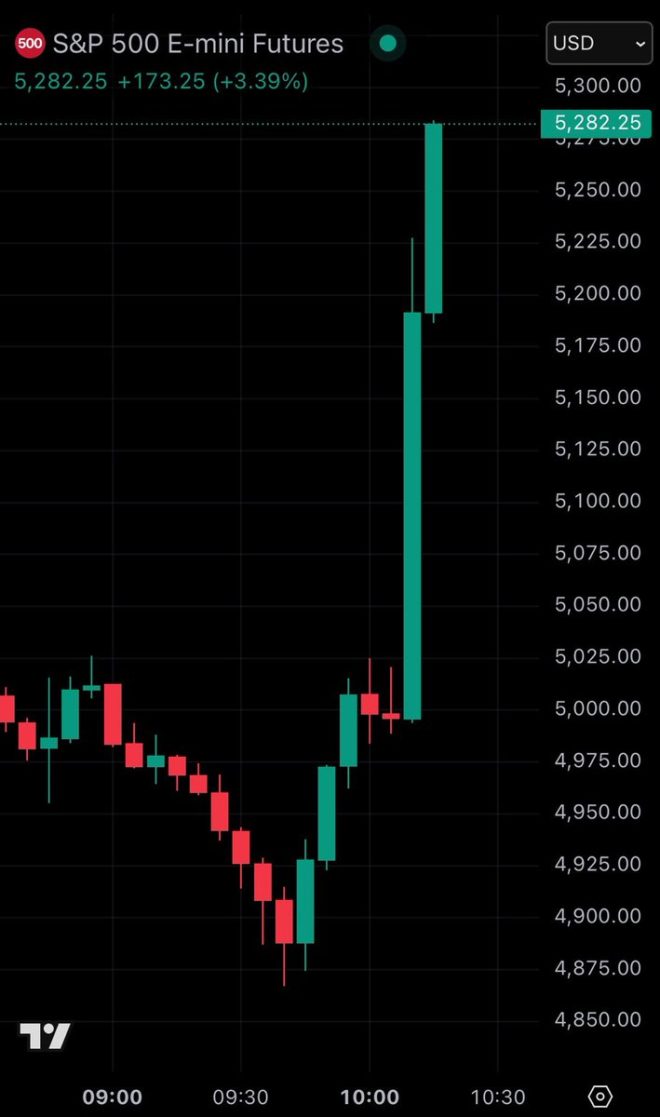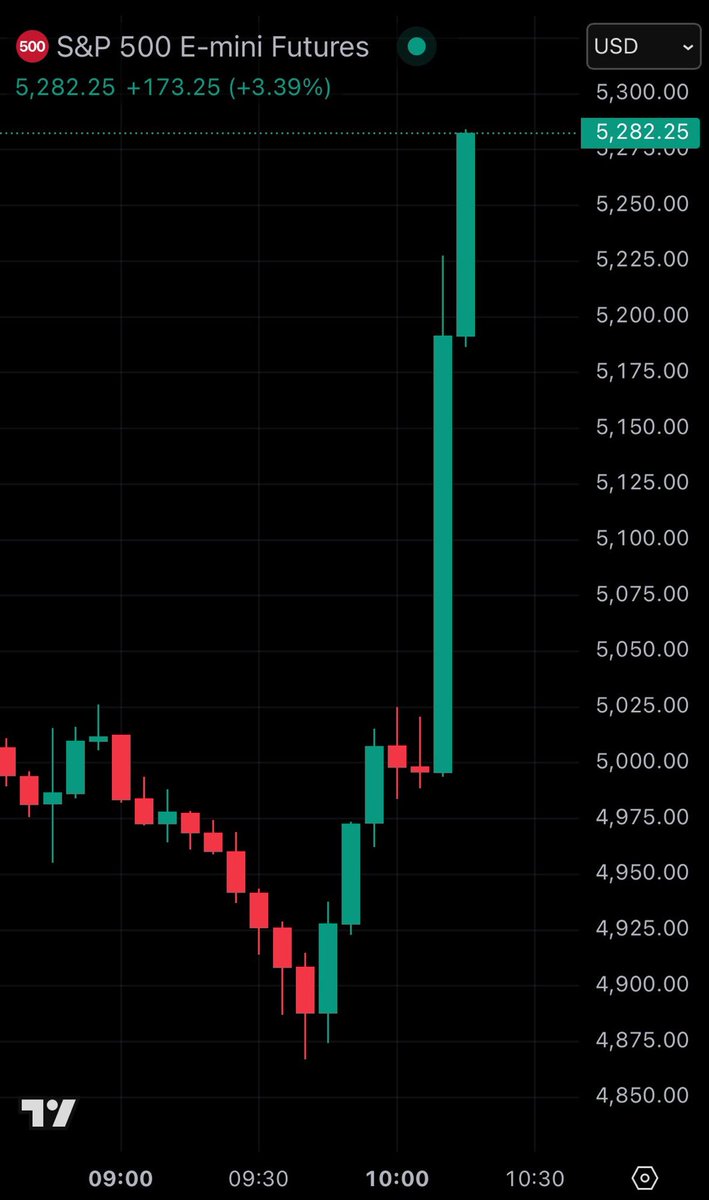
S&P 500 Surges by $4 Trillion in Response to news of Potential Tariff Pause
The stock market is notorious for its volatility, often reacting dramatically to news and policy changes. A striking example of this phenomenon occurred on April 7, 2025, when the S&P 500 Index surged by an astonishing $4 trillion within just 20 minutes. This rapid increase was triggered by reports that President Donald trump was considering a 90-day pause on tariffs, a move that could have significant implications for the U.S. economy and global trade relations.
Understanding the Context of the Market Reaction
The announcement of a potential tariff pause came amidst ongoing trade tensions and economic uncertainty. Tariffs, which are taxes imposed on imported goods, can significantly affect consumer prices, business costs, and overall economic growth. In recent years, the U.S. has engaged in various tariff disputes, particularly with major trading partners like China and the European Union. These disputes have created ripples throughout the global economy, leading to increased market volatility.
The prospect of a 90-day pause on tariffs signaled to investors that there might be a thawing in trade relations, potentially leading to a more stable economic environment. This optimism is what drove the rapid increase in the S&P 500, reflecting investors’ eagerness to capitalize on the potential for reduced trade barriers and improved business conditions.
The Role of Investor Sentiment
Investor sentiment plays a crucial role in stock market fluctuations. In this instance, the news of President Trump’s consideration for a temporary tariff pause instigated a wave of optimism among investors. Positive sentiment can lead to increased buying activity, driving stock prices up. In contrast, negative news can lead to panic selling, creating downward pressure on the market.
- YOU MAY ALSO LIKE TO WATCH THIS TRENDING STORY ON YOUTUBE. Waverly Hills Hospital's Horror Story: The Most Haunted Room 502
In the minutes following the announcement, investors flooded the market with buy orders, leading to a swift and significant increase in the S&P 500. The index, which includes 500 of the largest publicly traded companies in the U.S., serves as a barometer for the overall health of the stock market and the economy. A $4 trillion increase in the index reflects a substantial boost in market capitalization and investor confidence.
Implications of Tariff Changes
A pause on tariffs could have several ramifications for various sectors of the economy. For consumers, the reduction or elimination of tariffs on imported goods could lead to lower prices, enhancing purchasing power. For businesses, especially those reliant on global supply chains, a tariff pause could reduce costs and improve profit margins. This positive outlook could encourage businesses to invest more in expansion and innovation.
However, it is essential to note that a temporary pause does not equate to a permanent resolution to trade disputes. The implications of such a pause would depend on subsequent negotiations and policy decisions. Investors and analysts would closely monitor developments to gauge whether this pause would lead to more enduring solutions or if tariffs would be reinstated after the 90-day period.
The Broader Economic Impact
The stock market is often seen as a leading indicator of economic health. A rapid increase in the S&P 500 can signal investor confidence, which may translate into increased spending and investment in the broader economy. If businesses anticipate a more favorable trade environment, they may be more likely to hire, expand operations, and increase capital expenditures.
Conversely, uncertainty regarding trade policies can lead to caution among investors and businesses. The S&P 500’s response to the news reflects not only the immediate impact of the potential tariff pause but also the broader economic implications that could arise from improved trade relations.
Monitoring Future Developments
As the situation evolves, it will be crucial for investors, businesses, and policymakers to stay informed about developments related to trade policies and tariffs. The financial markets are sensitive to news and events, and even small changes can have significant effects on investor behavior and market performance.
In the weeks and months following the announcement, analysts will scrutinize economic indicators such as consumer spending, business investment, and employment rates to assess the real impact of any changes to tariff policies. The initial market reaction may serve as a temporary boost, but the sustainability of this momentum will depend on the actual economic outcomes resulting from the tariff pause.
Conclusion
The S&P 500’s remarkable $4 trillion increase in response to the news of a potential 90-day tariff pause illustrates the complex interplay between government policy, investor sentiment, and market dynamics. While the immediate reaction reflects a surge of optimism, the long-term implications remain to be seen. Investors and businesses alike will need to remain vigilant and adaptive as they navigate the uncertainties of trade relations and their effects on the economy.
This episode serves as a reminder of the significant influence that policy decisions can have on market behavior and the importance of staying informed in an ever-changing economic landscape. Understanding these dynamics can help investors make informed decisions and better position themselves for future market fluctuations.

HAPPENING: The S&P 500 adds +$4 TRILLION in 20 minutes as news breaks that President Trump is reportedly considering a 90-day pause on tariffs. pic.twitter.com/cUf3Hk1Twe
— Election Wizard (@ElectionWiz) April 7, 2025
HAPPENING: The S&P 500 Adds +$4 TRILLION in 20 Minutes as News Breaks That President Trump is Reportedly Considering a 90-Day Pause on Tariffs
On April 7, 2025, significant news rippled through the financial markets, creating a buzz that you could almost feel in the air. The S&P 500, a stock market index that measures the performance of 500 of the largest US companies, skyrocketed, adding a staggering $4 trillion in just 20 minutes. What was the cause of such a monumental shift? It all boiled down to a potential pause on tariffs as speculated by none other than former President Trump. This news sent investors into a frenzy, showcasing just how sensitive the stock market can be to political developments.
But what does a “90-day pause on tariffs” actually mean for the economy and the stock market? Let’s break it down.
Understanding Tariffs and Their Impact
Tariffs are taxes imposed on imported goods, designed to protect domestic industries by making foreign products more expensive. While they can benefit certain sectors, tariffs often create a ripple effect, impacting prices for consumers and altering trade balances. When news of potential tariff changes surfaces, it can create volatility in the stock market. Investors react quickly to these changes, and the swift rise in the S&P 500 illustrates just how closely tied the stock market is to political and economic news.
So, what does a pause on tariffs mean? Essentially, it signals a potential easing of trade tensions, which can lead to a more stable economic environment. In this case, the news about Trump considering a 90-day pause on tariffs was enough to shift investor sentiment dramatically.
The Immediate Reaction from Investors
The sheer weight of a $4 trillion increase in the S&P 500 in a mere 20 minutes highlights just how quickly market sentiments can shift. Investors often look for signals of health or distress in the economy, and the potential for reduced tariffs suggests a more favorable trading environment. This news likely reassured many investors who had been wary of ongoing trade wars and economic uncertainty.
But let’s be real—this kind of market reaction isn’t uncommon. When you have political figures like Trump weighing in on economic policies, the market tends to hang on every word. It’s a reminder of how intertwined politics and economics are, especially in today’s globalized world. Traders are always looking for indicators that can help them predict future movements, and tariff news is a critical factor in that equation.
Long-term Implications of a Tariff Pause
While the immediate reaction was overwhelmingly positive, the long-term implications of a 90-day pause on tariffs are more nuanced. For one, it could provide temporary relief to businesses that have been struggling under the weight of high tariffs. This could lead to increased consumer spending, as lower prices for imported goods might make their way back to the shelves, benefiting consumers directly.
However, it’s essential to approach this news with a critical eye. A pause on tariffs doesn’t equate to a permanent solution. If tariffs are reinstated after 90 days, it could lead to renewed market volatility. Additionally, the global economic landscape is constantly changing, and other factors—such as inflation, interest rates, and geopolitical tensions—could play a significant role in determining the overall impact on the economy.
The Role of Investor Sentiment
Investor sentiment is a powerful force in the stock market. When news like Trump’s potential tariff pause breaks, it can create a surge of optimism (or pessimism) that drives market movements. This phenomenon is why monitoring the news and understanding the broader economic context is crucial for investors.
In the case of the S&P 500’s $4 trillion jump, it was clear that many investors were eager to embrace the potential for a more stable trading environment. However, it’s important to remember that sentiment can change just as quickly as it rises. Economic indicators, earnings reports, and even geopolitical developments could shift investor perceptions overnight.
Analyzing the Broader Economic Context
When discussing the implications of a potential tariff pause, it’s essential to consider the broader economic context. The U.S. economy has been experiencing fluctuations driven by various factors, including inflation rates, employment numbers, and global trade dynamics. Understanding these factors can provide a clearer picture of what a 90-day tariff pause might mean for the economy moving forward.
One significant aspect to consider is how businesses have adapted to previous tariffs. Many companies have had to change their supply chains or pass costs onto consumers, which can impact overall economic growth. If a pause on tariffs can help stabilize these changes, it could lead to more sustainable growth in the long run.
Conclusion: What’s Next for Investors?
As investors, it’s natural to feel a mix of excitement and uncertainty in response to news like the potential pause on tariffs. While the $4 trillion surge in the S&P 500 is a positive development, it’s crucial to remain cautious and informed. The stock market is influenced by a myriad of factors, and understanding the implications of political news is just one part of the puzzle.
Keep an eye on economic indicators in the coming weeks and months. How businesses respond to this potential pause will be key in determining the longer-term effects on the economy. Whether you’re an experienced investor or just starting out, staying informed and adaptable will be your best strategy in navigating the ever-changing landscape of the stock market.
For those looking to dive deeper into the financial implications of tariff changes and market movements, resources like [Investopedia](https://www.investopedia.com) and [Yahoo Finance](https://finance.yahoo.com) can be incredibly helpful.
Stay tuned! The financial world is always evolving, and being informed is your best ally in making sound investment decisions.
Breaking News, Cause of death, Obituary, Today
